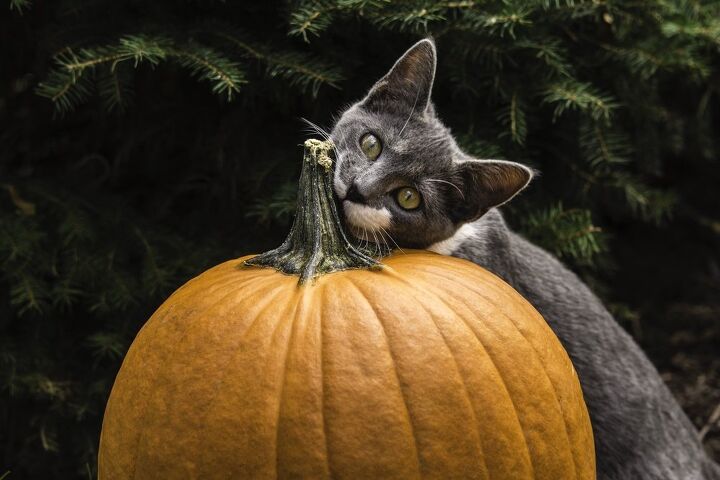Pumpkin for Cats – How and When to Use It

It might seem a little weird at first, but cats can eat pumpkin. How should pumpkin be administered to your cat, and when is it appropriate to use it? Check out the information below to learn more about the benefits of pumpkin for cats.
Supplementing your cat’s diet with some pumpkin may help your pet maintain healthy digestion. This food has a high amount of fiber, so if your kitty is dealing with some constipation issues, she might get some relief if she has some pumpkin added to her healthy, moisture-rich diet.
Related: Can Cats Eat Cheese?
In addition to helping with constipation, pumpkin may also help a cat who is having diarrhea. The fiber that’s found in pumpkin can help absorb the excess water in the digestive tract, thereby helping with firming up the stool.
Could your cat benefit from losing a couple of pounds? Your vet might recommend some strategies that you can implement, such as adding natural pumpkin to your pet’s food while reducing portion sizes. This can help your kitty feel full and satisfied even though she’s consuming a smaller amount of calories.
It doesn’t end there either. If your kitty has hairball problems, adding some pumpkin to her diet might even help clear the hair by moving it through the digestive tract.
Want to see if pumpkin could help regulate your cat’s digestion? Just make sure you stick with natural, plain canned pumpkin puree. Don’t use pumpkin pie filling, or any canned pumpkin that contains other ingredients, such as sugars and/or flavorings.
Related: Can Cats Eat Tuna?
You might start by mixing anywhere from 1 to 4 teaspoons of plain canned pumpkin into your adult kitty’s wet food, and you can do this once or twice a day. Kittens might only need ½ teaspoon dose. Start with a smaller amount and gradually increase, if needed. However, your vet might recommend a different dose depending on your kitty’s needs, health condition, age, and weight.
As an alternative to mixing plain canned pumpkin into your kitty’s wet food—or letting her lick it off a spoon, if she likes it enough—you could also search for high-quality canned food for cats that already contains this ingredient.
If you are thinking about adding pumpkin to your kitty’s diet, it is a great idea to consult with your veterinarian first, just to be sure that you are making the right choice, especially if your kitty has been diagnosed with a medical condition.
Although pumpkin is generally safe for cats, if you give your kitty too much, she might experience diarrhea. If this were to occur, you could try skipping a dose or just reducing the amount that you’re providing. As always, you can also gain valuable advice from your vet if any symptoms arise after you give your kitty pumpkin.
Also, if your cat is experiencing diarrhea and/or constipation often, consulting with your vet and having your cat examined will help you figure out what’s really going on that’s causing these digestive problems. And, once you have the correct diagnosis, the right treatment can be prescribed to help your pet feel better.
Bottom line: pure, plain, natural canned pumpkin might be a smart addition to your cat’s diet when provided in the appropriate amount and at the right frequency. However, it shouldn’t be considered a cure-all for digestive problems. If your kitty is experiencing digestive upset, whether it’s loose stools or constipation, it’s best to call your vet to let him or her know and to figure out if something like pumpkin, or another remedy, is necessary to get your companion’s health back on track.

Lisa Selvaggio is a freelance writer and editor, and our resident cats-pert, with certifications in pet nutrition and pet first aid. She enjoys producing content that helps people understand animals better so they can give their pets a safe and happy home.
More by Lisa Selvaggio























